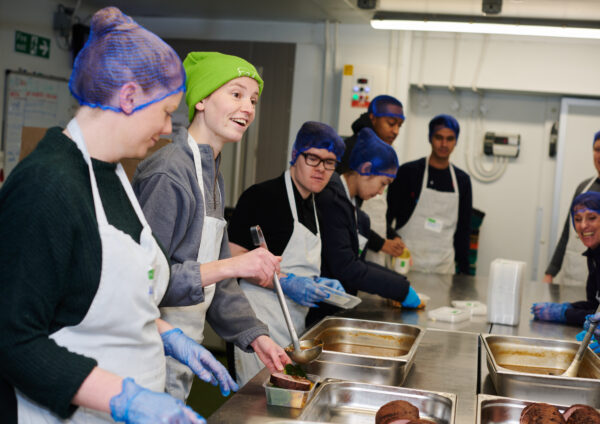
Giving Back
Why community-based giving matters
2nd May 2025
Westminster in central London might not be an obvious candidate for charitable giving, but AG’s 2025 focus on supporting London based charities, causes and organisations shines a light on those most in need
Ambassadeurs Group (AG) has been part of the Westminster community since Les Ambassadeurs Club first opened its doors in Hamilton Place, Mayfair, in 1941. It’s why, when AG announced new areas of focus to shape its giving back strategy in 2025, it placed an emphasis on London-based activity. The approach reflects the importance of the Group’s place in its Westminster community – and of community-based giving.
AG has raised over £2m for good causes since 2021, many of which have been in and around London. They include the Felix Project, which tackles food waste and hunger across London by rescuing and redistributing surplus food, and The Abbey Centre in the heart of Westminster. Since 1984 The Abbey Centre has been delivering community programmes for a cross-section of society that include the elderly, the homeless, refugees and those struggling with the cost-of-living.
‘The work of The Abbey Centre neatly sums up the reason why it is so important to look to our local area to give back,’ explains Krishna Hathi, Charity Initiatives Advisor at AG. ‘Many people might reasonably think that Westminster is a rich borough, but it is a place where the gap between those with and those without is marked. It’s why we have supported four key Abbey Centre projects [Refugee Meals, Homelessness Meals, Young at Heart, and The Community Pantry], and why we last year made an additional £25,000 donation to enable it to continue its Hot Meals Service to support homeless people, rough sleepers and refugees living in isolated accommodation for an extra 12 months.’
Giving back has to start close to home
The Abbey Centre projects are a reminder that beneath the rich exterior of the Westminster borough – which includes Belgravia, Knightsbridge and Mayfair, expensive shopping streets as well as palaces, luxury hotels, business headquarters and the seat of political power – are some of the UK’s poorest and most disadvantaged residents. ‘It is one of the most unequal boroughs in the country,’ explains Krishna.
According to the 2021 census which measures characteristics of people and households in a particular area, in some Westminster streets more than 73% of households were classed as ‘deprived’ by at least one measure. Church Street is home to one of the highest concentrations of social housing in the borough and some 60% of residents rely on benefits. This compares with just 10% in neighbouring areas such as Marylebone and Regents Park.
According to Trust for London Westminster’s overall poverty rate is worse than the London average, with 25.93% of residents living in poverty compared to 22.01% across England. Pay inequality is also pronounced, with the 80:20 earnings ratio being significantly worse than both the London and national averages. But it’s not just income or wealth that is the measure of deprivation or inequality. The borough has the largest gap in male life expectancy of any local authority in the country: some 18 years separates the poorest wards in the north from the wealthiest in the south.
Westminster: a place of contrasts
There are several factors that contribute to Westminster’s unique social landscape.
Housing: The borough contains both luxury developments and large social housing estates, often close to each other. High property prices and a large private rental sector (43% of households) mean that many residents face housing insecurity or overcrowding.
Demographics: Westminster is diverse, with some 85 languages spoken. International migration is the highest in England, which means there is a transient population with varying needs and challenges.
Economic Opportunities: Many jobs are low-paid or insecure.
Paying it forward
For AG, it is important to recognise where the Group can make a meaningful difference. Charities such as The Abbey Centre can help address immediate needs such as providing hot meals and a place for social interaction for refugees and a food pantry to support the most vulnerable during cost-of-living crises.
‘We know from our work with charities that things that sound simple – like companionship for elderly people or providing breakfast for young children – can be hard to achieve, and the lack of them can have a profound impact on people’s mental health and development,’ explains Krishna. ‘That’s why some of our giving back work in Westminster has been focused on helping reduce loneliness in old age, and ensuring children have proper, nutritious meals that help them concentrate at school.’
Adam Greenhalgh, Head of Community Programmes at The Abbey Centre, put in place a Theory of Change to measure the benefits of its programmes and they showed a positive impact in key areas that include loneliness and isolation, physical health, mental wellbeing and happiness, and access to financial security and basic needs.
AG’s 2025 philanthropic activity is centred of London-based activity and three key charities – chosen by the AG WorkFamily – will benefit under three areas of focus: Hospitality Action, as the key charity for education and employment; the Felix Project, as the key charity for support of Londoners in challenging circumstances; and the Royal Shakespeare Company (Creative Learning Programme) as the key charity to support arts and culture opportunities and accessibility.
The needs of the local community will continue to be a focus. ‘Charitable giving is not just about alleviating hardship; it is about fostering a more just and cohesive community,’ says Krishna. ‘In a borough as diverse and unequal as Westminster, supporting local charities means where we can, we will make a tangible difference to the lives of neighbours in need.’


